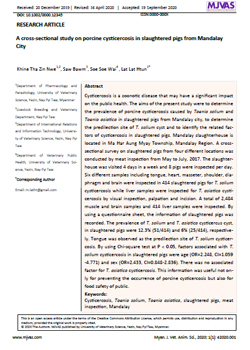
A cross-sectional study on porcine cysticercosis in slaughtered pigs from Mandalay City
Author: Dr. Lat Lat Htun Category: RESEARCH ARTICLE Publisher: UVS Published: July 18, 2020 ISBN: 0000-000XAbstract
Cysticercosis is a zoonotic disease that may have a significant impact on the public health. The aims of the present study were to determine the prevalence of porcine cysticercosis caused by Taenia solium and Taenia asiatica in slaughtered pigs from Mandalay city, to determine the predilection site of T. solium cyst and to identify the related fac-tors of cysticercosis in slaughtered pigs. Mandalay slaughterhouse is located in Ma Har Aung Myay Township, Mandalay Region. A cross-sectional survey on slaughtered pigs from four different locations was conducted by meat inspection from May to July, 2017. The slaughter-house was visited 4 days in a week and 8 pigs were inspected per day. Six different samples including tongue, heart, masseter, shoulder, dia-phragm and brain were inspected in 414 slaughtered pigs for T. solium cysticercosis while liver samples were inspected for T. asiatica cysti-cercosis by visual inspection, palpation and incision. A total of 2,484 muscle and brain samples and 414 liver samples were inspected. By using a questionnaire sheet, the information of slaughtered pigs was recorded. The prevalence of T. solium and T. asiatica cysticercus cyst, in slaughtered pigs were 12.3% (51/414) and 6% (25/414), respective-ly. Tongue was observed as the predilection site of T. solium cysticer-cosis. By using Chi-square test at P < 0.05, factors associated with T. solium cysticercosis in slaughtered pigs were age (OR=2.248, CI=1.059-4.771) and sex (OR=2.433, CI=0.848-2.836). There was no associated factor for T. asiatica cysticercosis. This information was useful not on-ly for preventing the occurrence of porcine cysticercosis but also for food safety of public.
Back
